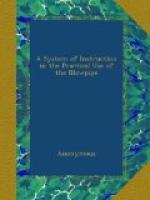in the oxidizing flame.
Even when in large proportion, dissolves to a clear glass, which is yellow when warm, but almost entirely loses its color on cooling. On charcoal, the antimonious acid may be almost expelled, so that tin produces no further change.
in the reducing flame.
A bead, that has only been treated for a short time in the oxidizing flame, when submitted to the reducing flame becomes grey and turbid from the reduced antimony. This soon volatizes and the glass again becomes clear. The addition of tin renders the glass ash-grey or black, according to the amount of oxide it contains.
Behavior with Mic. Salt on Platinum wire
in the oxidizing flame.
Dissolves with
ebullition to a glass of a pale yellow color
while warm.
in the reducing flame.
On charcoal, the saturated glass becomes at first dull, but as soon as the reduced antimony is volatilized, it again becomes clear. With tin, the glass is at first rendered grey by the reduced antimony, but by continued blowing is restored to clearness. Even when the glass contains but little oxide, tin produces this reaction.
* * * * *
29. Tungstic Acid, WO^{3}.
Behavior with Borax on Platinum wire
in the oxidizing flame.
Dissolves readily to a clear colorless glass. In large proportion it renders the borax yellow, while warm, and with a still greater addition the bead may be made opaque with an intermittent flame. If more be then added, this reaction takes place spontaneously.
in the reducing flame.
When the oxide is present in small quantity, the glass undergoes no change. With a larger proportion, the glass is deep yellow while warm, and yellowish-brown when cold. This reaction takes place upon charcoal, with a small quantity of the acid. Tin produces a dark coloration, when the acid is not present in too great a quantity.
Behavior with Mic. Salt on Platinum wire
in the oxidizing flame.
Dissolves to a
clear glass, which, when saturated, is yellow in
the hot state.
in the reducing flame.
The glass is of a pure blue. If the tungstic acid contain iron, the glass becomes blood-red on cooling, similar to titanic acid. In this case, tin restores the blue color, or, if iron be in considerable quantity, renders it green.
* * * * *
30. Molydbic Acid, MO^{3}.
Behavior with Borax on Platinum wire
in the oxidizing flame.
Dissolves readily and in large quantity. When but little is dissolved, the glass is yellow while hot and colorless when cold. When in larger quantity yellow while warm and opaline when cold, and a further addition of acid renders it yellow when warm, the color, on cooling, changing first to a pale enamel blue, and then to an enamel white.
in the reducing flame.




